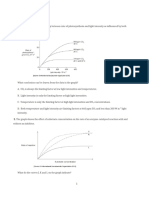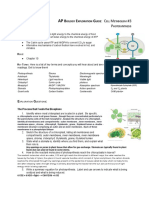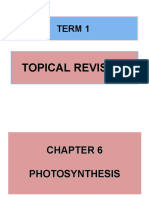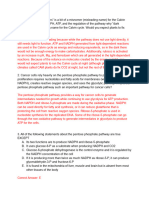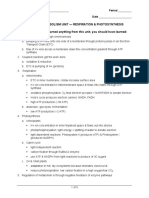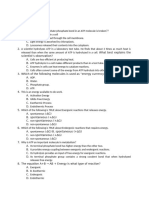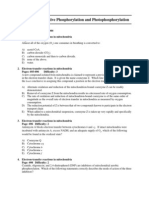Bio 20 Unit C Photosynthesis Test
Bio 20 Unit C Photosynthesis Test
Uploaded by
api-264036251Copyright:
Available Formats
Bio 20 Unit C Photosynthesis Test
Bio 20 Unit C Photosynthesis Test
Uploaded by
api-264036251Original Title
Copyright
Available Formats
Share this document
Did you find this document useful?
Is this content inappropriate?
Copyright:
Available Formats
Bio 20 Unit C Photosynthesis Test
Bio 20 Unit C Photosynthesis Test
Uploaded by
api-264036251Copyright:
Available Formats
Bio 20 Unit C Photosynthesis Test
20-C1.1k Explain, in general terms, how energy is absorbed by pigments,
transferred through the reduction of nicotinamide adenine dinucleotide phosphate
(NADP) to NADPH, and then transferred as chemical potential energy to ATP by
chemiosmosis; and describe where in the chloroplast these processes occur.
20-C1.2k Explain, in general terms, how the products of the light-dependent
reactions, NADPH and ATP, are used to reduce carbon in the light-independent
reactions for the production of glucose; and describe where in the chloroplast these
processes occur.
Multiple Choice
1. Which row correctly matches the pigment with its absorption spectrum?
A.
B.
C.
D.
Chlorophyll
Chlorophyll
Chlorophyll
Chlorophyll
a
b
a
b
Blue and green
Blue and indigo
Indigo and red
Yellow and green
2. Chemiosmosis takes place in the
.
A.
B.
C.
D.
Stroma
Stroma
Thylakoid membrane
Thylakoid membrane
and facilitates the production of
NADPH
ATP
NADPH
ATP
3. How many carbon atoms are in one molecule of RuBP?
A. Three
B. Four
C. Five
D. Six
4. The oxygen released during photosynthesis comes from the
A.
B.
C.
D.
Splitting of water molecules
Splitting of carbon dioxide molecules
Formation of ATP
Combination of oxygen and high-energy electrons
5. Which of the following is the correct sequence for the movement of electrons
during the light-dependent reactions in plants?
A.
B.
C.
D.
P680, P700, water, NADP+
water, P700, NADP+, P680
P680, water, P700, NADP+
water, P680, P700, NADP+
6. Which of the following statements accurately describes the relationship between
photosynthesis and cellular respiration?
A. Photosynthesis occurs only in autotrophs; cellular respiration occurs only in
heterotrophs
B. Photosynthesis involves the oxidation of glucose; respiration involves the
reduction of CO2
C. The primary function of photosynthesis is to use solar energy to synthesize
glucose; the primary function of cellular respiration is to break down glucose
and release energy
D. Photosynthesis and cellular respiration occur in separate, specialized
organelles; the two processes cannot occur in the same cell at the same time
7. What processes are responsible for maintaining the H + concentration gradient in
the thylakoid?
A.
B.
C.
D.
Photolysis and chemiosmosis
Chemiosmosis and fixation
Fixation and electron transport chain
Electron transport chain and photolysis
8. Which of the following is NOT a product of light-dependent reactions?
A.
B.
C.
D.
NADPH
ATP
O2
CO2
9. List the following steps in the Calvin Benson Cycle in the order that they occur.
I. CO2 is chemically bonded to a molecule in the stroma.
II. Glucose is synthesized from PGAL.
III. Unstable 6 carbon compound breaks down.
IV. Enzyme catalyzes the reaction between CO 2 and RuBP.
A.
B.
C.
D.
IV, I, III, II
I, IV, III, II
III, IV, I, II
II, III, I, IV
10. Photosystems are collections of pigments are found in the
A.
B.
C.
D.
Thylakoid space
Stroma
Thylakoid membrane
Granum
Fill in the Blanks
11. The Calvin Benson Cycle must be completed
molecule(s) of glucose.
time(s) to generate
12. The enzyme that catalyzes the reaction between carbon dioxide and RuBP is
called
.
13. When NADPH
, and becomes a
molecule PGAL.
PGA, the carbon compound gains
[higher/lower] energy
14. In order for light-dependent reactions to occur,
must be present.
and
Long Answer
15. A recently discovered species of tree has leaves that are entirely blue.
A) Explain why the leaves might appear to be blue. (1 mark)
B) Scientists decide to take the plant back to the lab for further study. They want
to make sure the plant thrives while they study it, so explain what colour of
light they would keep the tree under and why. (1 mark)
16. Below is a diagram of a thylakoid. Draw the different processes that occur in
light-dependent reactions in order to produce both ATP and NADPH. Be sure to draw
the reactions where they exactly occur in the thylakoid. (5 marks)
You might also like
- Answer Key Cellular Respiration PogilDocument6 pagesAnswer Key Cellular Respiration PogilErick Lazo Valdivia80% (10)
- Bingo EN With The Pattern Only211104 PDFDocument52 pagesBingo EN With The Pattern Only211104 PDFBZam Snts80% (5)
- Photosynthesis Worksheet Version 2 SHORT 2018 KEYDocument4 pagesPhotosynthesis Worksheet Version 2 SHORT 2018 KEYDeonLeo Cuenca100% (1)
- B1 - Liquid Level Control SystemDocument17 pagesB1 - Liquid Level Control Systemmoon star angel100% (1)
- Photosynthesis Worksheet Version 2 SHORT 2018 KEYDocument4 pagesPhotosynthesis Worksheet Version 2 SHORT 2018 KEYRosty Ann GrabilloNo ratings yet
- Old Photo Respiration Test With Answer KeyDocument11 pagesOld Photo Respiration Test With Answer KeySamuel SiyumNo ratings yet
- 13 Cellular Respiration-KEYDocument8 pages13 Cellular Respiration-KEYfkjnf100% (1)
- Worksheet Cellular Respiration#2 - Ch9 PDFDocument6 pagesWorksheet Cellular Respiration#2 - Ch9 PDFTaniaBarrios-ChongNo ratings yet
- Introduction To Blackfoot MetaphysicsDocument45 pagesIntroduction To Blackfoot Metaphysicsapi-264036251100% (1)
- GST Impact On Distribution NetworkDocument17 pagesGST Impact On Distribution NetworkrahulNo ratings yet
- Airtel Case StudyDocument8 pagesAirtel Case StudySurya Prakash50% (2)
- 01-IGDOM-Foundr Workbook FullDocument144 pages01-IGDOM-Foundr Workbook FullJerry Cardish100% (2)
- KPMG - Target Operating ModelDocument2 pagesKPMG - Target Operating ModelSudip Dasgupta100% (2)
- 2 Semester Final Exam (2009A.Y.) Grade 11 Subject: Biology Time: 1:10 Mark: 40%Document5 pages2 Semester Final Exam (2009A.Y.) Grade 11 Subject: Biology Time: 1:10 Mark: 40%Nahom GarefoNo ratings yet
- Photosynthesis WorksheetDocument5 pagesPhotosynthesis WorksheetAshley JohnsNo ratings yet
- Nejib Bio Item gr-11 ch-5 Sec. B, C,& I AssignmentDocument8 pagesNejib Bio Item gr-11 ch-5 Sec. B, C,& I AssignmentDaniel GtsadkanNo ratings yet
- DP1 BioHL - Topic 8 - Revision WorksheetDocument30 pagesDP1 BioHL - Topic 8 - Revision WorksheetlesedimamareganeNo ratings yet
- Questions PhotosynthesisDocument3 pagesQuestions Photosynthesissahjyanshu08No ratings yet
- APBioCh10ReadingGuide10 11Document2 pagesAPBioCh10ReadingGuide10 11Sergio LivingroomsNo ratings yet
- Biology Grade 12 PreparationDocument8 pagesBiology Grade 12 PreparationNafiyaf BerhanuNo ratings yet
- Biology Practice PhotosynthesisDocument7 pagesBiology Practice Photosynthesisbrowhocares121212No ratings yet
- Chapter 10 Multiple Choice Practice: CO H O O PDocument7 pagesChapter 10 Multiple Choice Practice: CO H O O PShaira CogollodoNo ratings yet
- 1.which Process Is Common To Photosynthesis and Cell Respiration?Document6 pages1.which Process Is Common To Photosynthesis and Cell Respiration?571170532No ratings yet
- Kerala +1 Botany Focus Area Question Bank - Respiration in PlantsDocument3 pagesKerala +1 Botany Focus Area Question Bank - Respiration in PlantsMolly KuttyNo ratings yet
- Unit 8 TestDocument12 pagesUnit 8 TestTaiba NoorNo ratings yet
- Photosyntesis Worksheet 3Document5 pagesPhotosyntesis Worksheet 3Ryan De AlloNo ratings yet
- Mark Marlatt - Photosynthesis Pogil Track D - 5261224Document11 pagesMark Marlatt - Photosynthesis Pogil Track D - 5261224api-544304176No ratings yet
- AP Biology Exploration Guide - Cell Metabolism #3Document6 pagesAP Biology Exploration Guide - Cell Metabolism #3Gunnar OlsonNo ratings yet
- TERM 1 Chapter 6 Topical RevisionDocument71 pagesTERM 1 Chapter 6 Topical Revisionlaiyinah 09No ratings yet
- Botanica Lab Virtual 1Document8 pagesBotanica Lab Virtual 1Equalis SantosNo ratings yet
- Long Quiz Exam (2ND Quarter)Document2 pagesLong Quiz Exam (2ND Quarter)Sheryl Lou AngelesNo ratings yet
- 2nd Monthly ExamDocument3 pages2nd Monthly ExamSheryl Nishmae Bernardo SantosNo ratings yet
- 11 PhotosynthesisDocument11 pages11 Photosynthesisava derosaNo ratings yet
- AP Biology Chapter 10 Notes - PhotosynthesisDocument5 pagesAP Biology Chapter 10 Notes - PhotosynthesisAustinNo ratings yet
- Revision Questions Class 11 Part 1Document2 pagesRevision Questions Class 11 Part 1umair.sachora11561No ratings yet
- Quiz Photo and Cell RespDocument3 pagesQuiz Photo and Cell RespElpi FerrerNo ratings yet
- AP Bio CHAPTHER 9 Guided ReadingDocument7 pagesAP Bio CHAPTHER 9 Guided ReadingSadmoodNo ratings yet
- Chapter 10. Photosynthesis AnswersDocument3 pagesChapter 10. Photosynthesis Answerskarlitarmz100% (2)
- Problem Set BS20001 PhotosynthesisDocument2 pagesProblem Set BS20001 PhotosynthesisAbhinaba SahaNo ratings yet
- Key CT BioenergeticsDocument4 pagesKey CT Bioenergeticschoudharyasif9999No ratings yet
- Photosynthesis WorksheetDocument4 pagesPhotosynthesis WorksheetJustin Marju De VeraNo ratings yet
- 11 Final ExamDocument14 pages11 Final ExamTadesse MindaNo ratings yet
- Lecture 23 Post-Lecture Answers-1Document3 pagesLecture 23 Post-Lecture Answers-1Taul AlexNo ratings yet
- Respiration - Cell Cycle ReviewDocument11 pagesRespiration - Cell Cycle Reviewwrdq6bn4w5No ratings yet
- Photosynthesis POGIL Answer KeyDocument10 pagesPhotosynthesis POGIL Answer KeyAbby BartolataNo ratings yet
- Photosynthesis in Higher Plants: Class: 11 Sub: Biology Chapter - 13Document7 pagesPhotosynthesis in Higher Plants: Class: 11 Sub: Biology Chapter - 13kuldeep kumarNo ratings yet
- Chapter 15 Cellular Respiration 1Document6 pagesChapter 15 Cellular Respiration 1zeemboyzNo ratings yet
- Review 3: Metabolism Unit - Respiration & Photosynthesis A. Top "10" - If You Learned Anything From This Unit, You Should Have LearnedDocument6 pagesReview 3: Metabolism Unit - Respiration & Photosynthesis A. Top "10" - If You Learned Anything From This Unit, You Should Have LearnedNguyen Thi Thien MinhNo ratings yet
- Cells Respiration & Photosynthesis TestDocument7 pagesCells Respiration & Photosynthesis Testlingcoong9415100% (1)
- Workshop 8 PDT 3Document4 pagesWorkshop 8 PDT 3leafyfun100No ratings yet
- Bio Tutorial 7Document4 pagesBio Tutorial 7Viyasinei KumaramoneyNo ratings yet
- AP Biology CH 8 - Photosynthesis - Test Questions and Answers 100% AccurateDocument5 pagesAP Biology CH 8 - Photosynthesis - Test Questions and Answers 100% AccuratewakwabubifelixNo ratings yet
- Photosynthesis Review Packet Key 2018Document6 pagesPhotosynthesis Review Packet Key 2018annihilator596No ratings yet
- 2nd Quarter Take Home QuizzesDocument7 pages2nd Quarter Take Home QuizzesnarcillamarkadrianNo ratings yet
- Activity 10 Answer KeyDocument8 pagesActivity 10 Answer KeyRyan LeeNo ratings yet
- 13 Cellular Respiration-KEYDocument6 pages13 Cellular Respiration-KEYgilNo ratings yet
- Q2 STEM General Biology 1 Week 2Document4 pagesQ2 STEM General Biology 1 Week 2MarkElijah ObelNo ratings yet
- Kami Export - ALEXA CADENA - 13 Cellular Respiration-SDocument6 pagesKami Export - ALEXA CADENA - 13 Cellular Respiration-SALEXA CADENANo ratings yet
- STPM Biology Past Year QuestionDocument8 pagesSTPM Biology Past Year QuestionMc Donalds Ohl Ohlsen100% (2)
- Chapter 5: Microbial MetabolismDocument3 pagesChapter 5: Microbial MetabolismNetra AgarkarNo ratings yet
- Biology Unit 5 Review QuestionsDocument9 pagesBiology Unit 5 Review QuestionsMoa ArmyNo ratings yet
- Sbi 4u1photosynthesis Quiz2009Document4 pagesSbi 4u1photosynthesis Quiz2009api-270880889No ratings yet
- 13 Cellular Respiration-KEYDocument7 pages13 Cellular Respiration-KEYCole BeinerNo ratings yet
- 13 Cellular Respiration-KEYDocument7 pages13 Cellular Respiration-KEYNicholas SchmidtNo ratings yet
- Chapter 19 Oxidative Phosphorylation and PhotophosphorylationDocument8 pagesChapter 19 Oxidative Phosphorylation and PhotophosphorylationTony Nguyen33% (3)
- Sustainable synthesis of ciclopentene derivatives through multicomponent reactions in continuous flow regimeFrom EverandSustainable synthesis of ciclopentene derivatives through multicomponent reactions in continuous flow regimeNo ratings yet
- Organic Reaction Mechanisms 1981: An annual survey covering the literature dated December 1980 through November 1981From EverandOrganic Reaction Mechanisms 1981: An annual survey covering the literature dated December 1980 through November 1981A. C. KnipeNo ratings yet
- Math 9 Course Outline 2019-2020 1Document3 pagesMath 9 Course Outline 2019-2020 1api-264036251No ratings yet
- 9e Math CalendarDocument6 pages9e Math Calendarapi-264036251No ratings yet
- 9e Sci Remote Learning PlanDocument5 pages9e Sci Remote Learning Planapi-264036251No ratings yet
- Grade 8 UbdDocument9 pagesGrade 8 Ubdapi-264036251No ratings yet
- Learning Leadership ApplicationDocument2 pagesLearning Leadership Applicationapi-264036251No ratings yet
- Ants Lesson PlanDocument4 pagesAnts Lesson Planapi-264036251No ratings yet
- 2020 CVDocument2 pages2020 CVapi-264036251No ratings yet
- Tomato Production Guideline 2019 200908 054054Document13 pagesTomato Production Guideline 2019 200908 054054Nazmul HaqueNo ratings yet
- Manual For Vermiculture BiotechnologyDocument23 pagesManual For Vermiculture BiotechnologySravan Kaniganti100% (2)
- Calotropis Procera, Eichhornia Crassipes and Datura Innoxia LeavesDocument4 pagesCalotropis Procera, Eichhornia Crassipes and Datura Innoxia LeavesSuhar TomiNo ratings yet
- P2PMOBILE: A Framework For Remote Execution in Mobile EnvironmentDocument10 pagesP2PMOBILE: A Framework For Remote Execution in Mobile EnvironmentMohd WasifNo ratings yet
- An Introduction To Materials Engineering and ScienceDocument7 pagesAn Introduction To Materials Engineering and ScienceMohammed KamalNo ratings yet
- Ts Grewal Solutions For Class 11 Account Chapter 15 MinDocument36 pagesTs Grewal Solutions For Class 11 Account Chapter 15 Minrocking toxtricityNo ratings yet
- B9 - High Power Contactors (Ref) enDocument44 pagesB9 - High Power Contactors (Ref) enPablo Andres Jara GonzalezNo ratings yet
- Preliminary Activities: Good Morning Class! How Are You This Morning?Document5 pagesPreliminary Activities: Good Morning Class! How Are You This Morning?taw realNo ratings yet
- 5SDocument23 pages5SReetu Sri100% (2)
- MMOB-3B AttemptsDocument1 pageMMOB-3B AttemptsdangreenleeNo ratings yet
- ISE Micro ProjectDocument13 pagesISE Micro Projectshahutsav323No ratings yet
- The LMS Test - Lab Modal Analysis Manual: Rev 12ADocument511 pagesThe LMS Test - Lab Modal Analysis Manual: Rev 12ASevilia Sunetchiieva100% (1)
- T SP OB.تةي1016 2012 OAS MSW EDocument47 pagesT SP OB.تةي1016 2012 OAS MSW Ekhaled syNo ratings yet
- 6-8 Business in Brief PDFDocument85 pages6-8 Business in Brief PDFAsaNo ratings yet
- PTT PHENOL Column Cumene Cleaning & Decontamination ReportDocument15 pagesPTT PHENOL Column Cumene Cleaning & Decontamination ReportArie PanjunanNo ratings yet
- SAMPLE Loan PackageDocument84 pagesSAMPLE Loan PackageChris JacksonNo ratings yet
- MEFA Questions and AnswersDocument15 pagesMEFA Questions and AnswersG. Somasekhar SomuNo ratings yet
- RS232 485 FundamentalDocument47 pagesRS232 485 FundamentalSanket Karnik100% (3)
- Critical AnalysisDocument5 pagesCritical Analysisapi-585052655100% (1)
- Vaizdai Daugiau: Audi A4 v159Document10 pagesVaizdai Daugiau: Audi A4 v159Andrius DaraškevičiusNo ratings yet
- Refrigerant Unit Lab ReportDocument19 pagesRefrigerant Unit Lab Reportakmal100% (2)
- Custodio - Research Paper Cad4Document5 pagesCustodio - Research Paper Cad4Nicole CustodioNo ratings yet
- White Simple Student CV ResumeDocument1 pageWhite Simple Student CV Resumekankipati.yeswanthNo ratings yet
- Karuna's Neuroscience Motivational LetterDocument2 pagesKaruna's Neuroscience Motivational LetterbisnunepmanyNo ratings yet
























